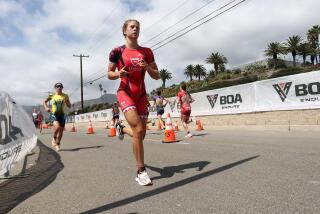Gear: Putting new triathlon gadgets through their paces
- Share via
The explosive growth of triathlons — the number of participants has doubled in the last three years to 1.2 million — has also had an explosive effect on sports technology. Every triathlete, no matter the age or ability, is a racer — and practically every racer is a gearhead, lusting after innovations that will help him or her go faster. Since money is often no object for the swim-bike-run crowd, product designers with far-out idea are working overtime. Here’s what they’ve come up with lately.
High-tech trek
Trek Speed Concept 9 Series: Family of lightweight carbon triathlon and time-trial bikes have aerodynamic tubing and parts integration that Trek claims make the world’s fastest bike, based on wind tunnel data.
Likes: Aerodynamic and practical. A “Kammtail” shape (sort of a chopped-off teardrop) in the down tube, seat tube, stays and fork blades supposedly maintains smooth airflow as it makes the bike lighter, stiffer and more stable in crosswinds. It’s paired with integrated brakes, shifter cables, electronic sensors, storage compartments and skewers, all hidden from the wind inside or flush with the frame itself. The rear tool box doubles as a wheel shroud. An optional speed-and-cadence sensor ($59.99) that syncs with any computer and power meter using the ANT+ protocol is embedded in the chain stay; no zip-ties needed. Lower-end 7 Series bikes ($2399 to $3499) combine these features with a conventional fork/headtube/brake. Aluminum-frame 2 Series is $2000.
Dislikes: None.
Price: $5,499 to $8,499, based on components. (800) 313-8735; https://www.trekbikes.com
Adjustable aero head
Rudy Project Wingspan helmet: Designed by aerodynamics guru John Cobb, this triathlon/time-trail helmet combines a wind-cheating teardrop shape and ear shrouds with massive vents and removable vent covers. Rudy Project claims its testing proved this to be the fastest helmet for all body types.
Likes: Since your head’s like a radiator, typical minimally vented time-trial helmets can risk overheating you. This one lets you change the vents to balance speed and comfort. Leave the front and rear vents wide open on hot days and during long Ironman races, or block them with various included covers to cut wind resistance on cooler days and in shorter races. A twist-dial rear strap makes for a comfy custom fit. New neon colors make you highly visible on the road. Weight: 330 grams with covers, 310 grams without.
Dislikes: None, except the price.
Price: $299.99. Fluorescent colors add $25. (888) 860-7597; https://www.e-rudy.com
Different strokes
Finis Swimsense: Utilizing motion-sensing technology, this is the first wristwatch monitor that can distinguish between strokes (freestyle, back, butterfly and breast). It can also record and download to your PC your laps, distance, calories burned, lap time, pace and stroke count.
Likes: It works well, has a classy rectangular shape, functions as a regular date-and-time watch, and is easy to use and view. You can access up to 14 past swim workouts on the monitor as well as your current session. Data can be uploaded to the Swimsense Training Log for analysis. Settings are easily configured for pool sizes, gender and weight.
Dislikes: No backlight. Also, despite the great data, the price begs for more features, like heart rate.
Price: $199.99. (888) 333-4647; https://www.finisinc.com.
Super-duper sports watch
Timex Ironman Global Trainer: A gargantuan, all-in-one, waterproof, GPS-enabled speed-and-distance sports watch/heart rate monitor that can display a variety of information in four separate on-screen windows.
Likes: Everything a multi-sport tech geek needs in an easy-to-use design. In the same league as similar models from Garmin, it stands out with easy customize-ability and its quad-pane display, which highlights your most desired stats so you don’t have to use scroll buttons to find them. For instance, while running I had heart rate, distance, pace and a timer displayed. You can set training zones and alarms for more than 50 performance parameters. With a 1.5-inch screen and seven big, tactile buttons, it’s easy to read and scroll through while in motion. A free account lets you view basic training data on your PC; a premium plan with more analytical tools costs $20 a month. Battery life is 15 hours.
Dislikes: Like all GPS units, it disappoints swimmers; water interrupts its signal, preventing accurate distance readings. It’s bulky at 2.25 inches wide and 0.63 inches thick. The Indiglo backlight is weak.
Price: $300 ($360 with HRM strap). (800) 448-4639; https://www.timexironman.com
Wallack is the author of “Bike for Life” and “Run for Life.”






